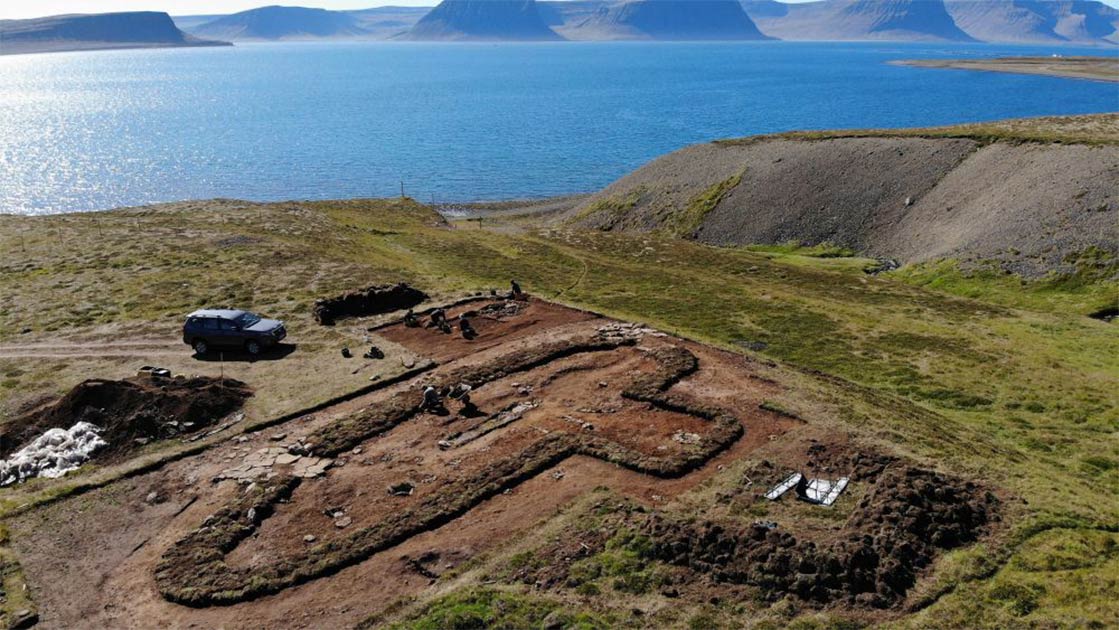Longhouse From Icelandic Medieval Saga Discovered at Arnarfjörður
In 2013 archaeologists in Iceland came across an ash pile which led to excavations that began in 2017 at Arnarfjörður, near the church town Auðkúla in Iceland. The ash pile led to the discovery of a 10th century farming settlement and over the last three years the archaeologists have been unearthing the layers of evidence. Now, at the end of the 2020 excavation season, an entire earthen house and hut have been uncovered.

The archaeological site at Arnarfjörður was identified in 2017 with the discovery of an ash pile. In the summer of 2020, archaeologists excavated the 10th century farming settlement. (Margrét Hallmundsdóttir / RUV)
Following the Clues in Ancient Sagas
Written in the first half of the 12th century, Landnámabók is the oldest ever written source to have been discovered detailing the early settlement of Iceland. This epic work of history presents a list of the first Icelandic inhabitants and their families, including 3,000 proper names and 1,400 place names. According to Landnámabók, the earliest settler in Svínadalur was Eyvindur Audkúla, and around 1300 AD Kolbeinn Bjarnason Auðkýlingur became a Jarl (Earl). From these ancient entries archaeologists have slowly uncovered what they believe is the early 10th century settlement mentioned in the saga.
According to RUV, archaeologists in Iceland discovered an earth house in which they found a large furnace with cracked rocks. In an adjacent hut measuring 23 meters long, a traditional log fire was discovered. Back in 2019, the hut was found after a drill core study and further survey ditches were created this summer. According to Dr. Margrét Hallmundsdóttir, the archaeologist leading the study, the hut is "very large, and the floor is at least seventeen meters long.” Not only is another hut believed to be located nearby, but an iron workshop, a cowshed and three further houses are expected to be located within dig site that they were all connected with iron mining over 1000 years ago.

According to Dr. Margrét Hallmundsdóttir, the archaeologist leading the study, the hut discovered at the remote 10 th farm is "very large, and the floor is at least seventeen meters long.” (Margrét Hallmundsdóttir / RUV)
Fjord of the Sea Monsters
Iceland was one of the last countries in the world to be Christianized and superstitions still run deep. This is evident, for example, in a Guide to Iceland article that talks of supernatural “sea monsters” that have inhabited the adjacent waterway ever since the Vikings settled Iceland around 874 AD. Over the last century alone there have been over “4,000 recorded sightings of sea monsters and lake monsters around Iceland,” many of the sea monsters have been seen in Arnarfjörður, and the Westfjords of Iceland, with “some 180 recorded sightings of sea monsters have been reported in Arnarfjörður fjord alone!”
This remote 10th century farm is located in a spectacular position overlooking the famous historic waterway. Archaeologist Margrét Hallmundsdóttir, in charge of the excavations, said agricultural activity at Skálabyggingar lasted for hundreds of years but underwent significant changes over the centuries. The discovery of the building she calls a “pavilion,” clearly confirms the long-standing hypothesis among Icelandic archaeologists that “pavilions” were built in ancient Iceland.

The team not only excavated the site, but they also used non-penetrative techniques using drones equipped with thermal cameras looking for new archaeological evidence. (Margrét Hallmundsdóttir / RUV)
Saga Hunting With High-Tech Eyes in the Sky
The archaeologists excavating in Iceland not only dig test trenches and take core drill samples, from deep within the often frozen soils, looking for evidence of the early 10th century settlers. They also use non-penetrative prospecting techniques by flying high-tech drones equipped with thermal cameras up and down the coastlines of the fjords, looking for anomalies that might indicate new archaeological evidence. Using this non-penetrating technology “a lot of monuments that were not known about in Arnarfjörður in the Westfjords have been located.”
- Icelander Sagas May Have More Truth to Them than You Think
- Icelandic Government Commission Announces Legendary Sea Monster Exists
- Outlaws, Trolls and Berserkers: Meet the Hero-Monsters of the Icelandic Sagas
The archaeological knowledge about how this ancient farm and ironworks functioned is increasing every year. But what is perhaps equally as interesting is that this project is also helping to separate facts from fiction with the pages of the ancient written sagas, such as the medieval Landnámabók. Once believed to be purely mythological, archaeological investigations are leading to the conclusion that at least some of the Icelandic saga stories, poems and tales were actually based on real people, places and events. The RUV article concludes that drones are helping to identify “monuments mentioned in early written sagas.”
Top image: Archaeological excavation at Arnarfjörður has unearthed huge amounts of data. Researchers have also found data within the texts of ancient Icelandic sagas, as well as drone technology to identify possible dig sites. Source: Margrét Hallmundsdóttir
By Ashley Cowie



















